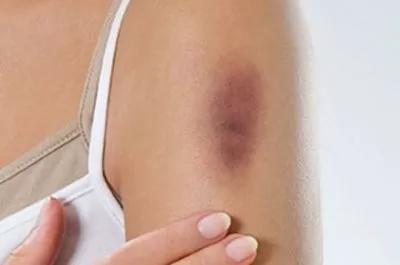A hematoma is a medical condition characterized by the accumulation of blood outside of blood vessels, usually as a result of trauma or injury. While hematomas can occur in various parts of the body, a hematoma in the leg can be particularly concerning. In this article, we will explore the causes, symptoms, and potential dangers associated with leg hematomas. We will also discuss the importance of proper diagnosis and treatment to minimize the risks and ensure a safe recovery.
What is a leg hematoma?
An injury to small blood vessels such as capillaries is called a bruise, whereas if larger blood vessels are involved, it is called a hematoma. A leg hematoma refers to the collection of blood within leg tissue following an injury or trauma. It occurs when blood vessels rupture, leading to bleeding into the surrounding tissues. Leg hematomas can vary in size, from small bruises to large swollen areas. While most leg hematomas are not life-threatening, they can cause significant discomfort and may indicate underlying issues that require medical attention.
Causes of leg hematomas
The most common cause is direct trauma or injury to the leg, such as a fall, sports-related injury, or accident. In some cases hematomas may also occur spontaneously, without any apparent external cause. This can be attributed to certain medical conditions or medications that affect blood clotting, making the blood vessels more prone to rupture. Additionally, individuals taking anticoagulant medications or those with underlying blood clotting disorders may be at a higher risk of developing leg hematomas.
Symptoms of a leg hematoma
The symptoms of a leg hematoma can vary depending on the severity and location of the injury. Common signs and symptoms include:
- Swelling, bruising and discoloration of the skin, typically in shades of blue, purple, or black
- Pain and tenderness particularly when pressure is applied to the affected area. The leg may feel tender and sensitive to touch
- A large hematoma can restrict movement and make it difficult to bend or straighten the leg resulting in a limited range of motion
- Warmth, redness and inflammation surrounding the skin of the hematoma
- Individuals may experience sensations of numbness or tingling in the affected leg
Are leg hematomas dangerous?
One of the main concerns with hematomas is the possibility of an infection. A localized infection can develop if bacteria enters the hematoma through an open wound. This can lead to symptoms such as increased pain, fever, and the formation of pus. Prompt medical attention is crucial to prevent the spread of the infection.
Another potential danger of leg hematomas is the risk of compartment syndrome. Compartment syndrome occurs when pressure builds up within a muscle compartment, leading to reduced blood flow and potential muscle and nerve damage. This condition can be particularly concerning in cases of large or expanding hematomas. Symptoms of compartment syndrome include severe pain, numbness or tingling, muscle weakness, and pale or shiny skin. Immediate medical intervention is necessary to alleviate pressure and restore blood flow to the affected area.
Diagnosis and treatment
Seeking medical attention
It is important to seek medical attention for an accurate diagnosis and appropriate treatment if you suspect a leg hematoma. A healthcare professional will carry out a thorough physical examination and may order additional tests if they consider it useful. These tests may include an X-ray, ultrasound, MRI or CT scans.
Treatment options
Treatment will depend on the type of hematoma as well as the size, location of the hematoma, and severity of the injury. In mild cases, it is similar to treating other soft tissue injuries.
Using the R.I.C.E method (rest, ice (towel-wrapped ice pack), compression (via elastic bandages), elevation) on the injured area is recommended. Pain and discomfort can be treated with over-the-counter medication, such as Tylenol (acetaminophen), or prescribed pain medications. Do not however, take aspirin or ibuprofen (Advil) as these can slow blood clotting.
For more severe or complicated cases, immediate medical attention such as drainage procedures or surgical evacuation of the hematoma may be necessary. These methods aim to remove the accumulated blood and relieve pressure on surrounding tissues. Antibiotics may be prescribed if there is evidence of infection.
Preventing leg hematomas
While some leg hematomas may be unavoidable, there are measures individuals can take to reduce their risk:
- Head injuries that occur when engaging in high-risk activities or sports can be minimized by wearing appropriate protective gear, such as helmets. Knee pads and shin guards, can also help minimize the impact of potential injuries
- Taking precautions, such as removing tripping hazards, installing handrails on stairs, and using nonslip mats in the bathroom to prevent falls can significantly reduce the risk of leg hematomas
- If you are taking blood thinners (such as warfarin or clopidogrel) or have a bleeding disorder it is crucial to follow your healthcare provider’s instructions carefully and attend regular check-ups to monitor your condition
Conclusion
Leg hematomas can be painful and debilitating but they are typically not life-threatening. However, it is crucial to seek medical attention for an accurate diagnosis and appropriate treatment to minimize the potential risks and complications associated with these injuries. Remember, if you experience symptoms of a leg hematoma or have concerns about your health, consult a healthcare professional for guidance, support and medical care.
Sources
Medical Disclaimer
NowPatient has taken all reasonable steps to ensure that all material is factually accurate, complete, and current. However, the knowledge and experience of a qualified healthcare professional should always be sought after instead of using the information on this page. Before taking any drug, you should always speak to your doctor or another qualified healthcare provider.
The information provided here about medications is subject to change and is not meant to include all uses, precautions, warnings, directions, drug interactions, allergic reactions, or negative effects. The absence of warnings or other information for a particular medication does not imply that the medication or medication combination is appropriate for all patients or for all possible purposes.







